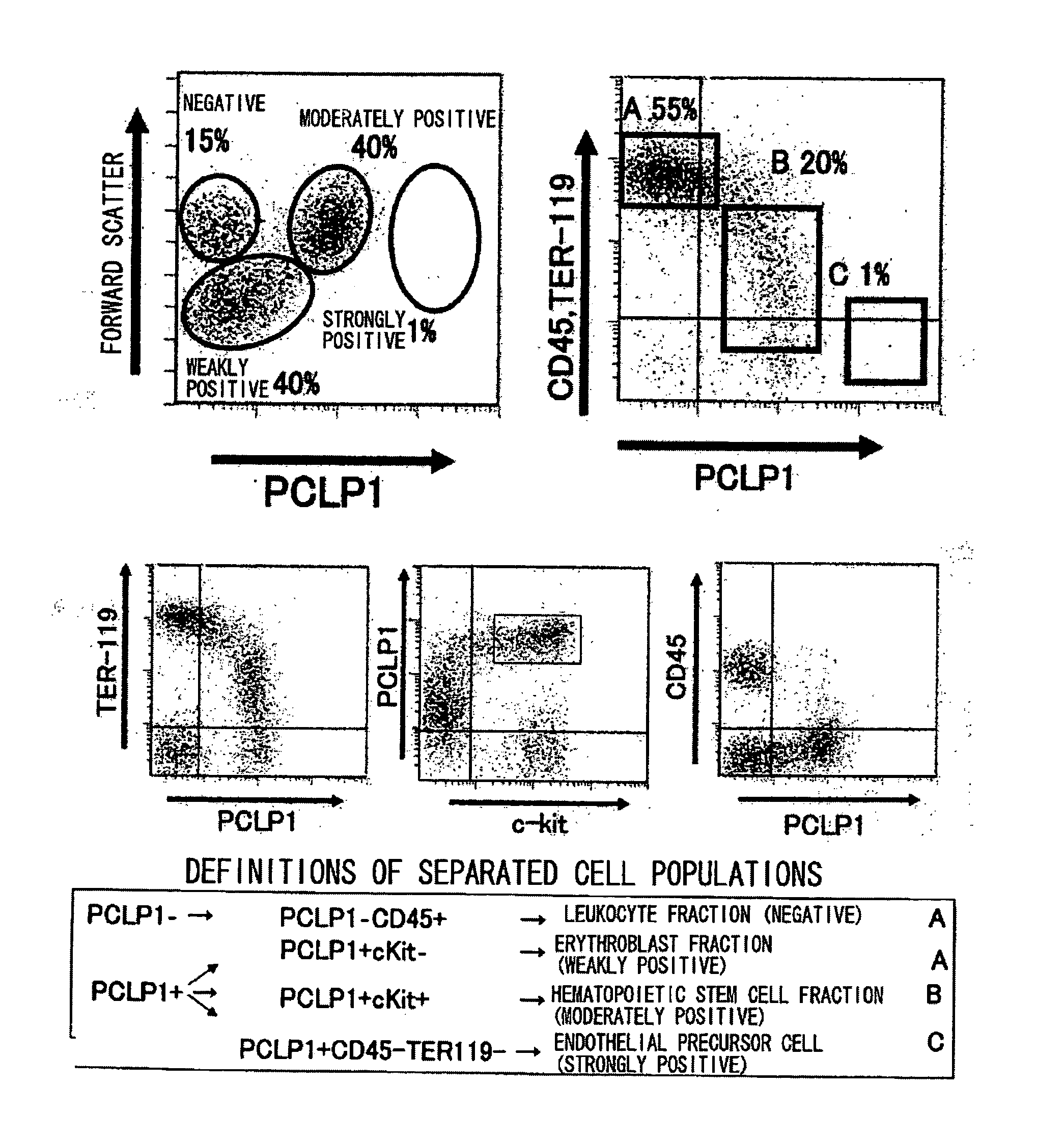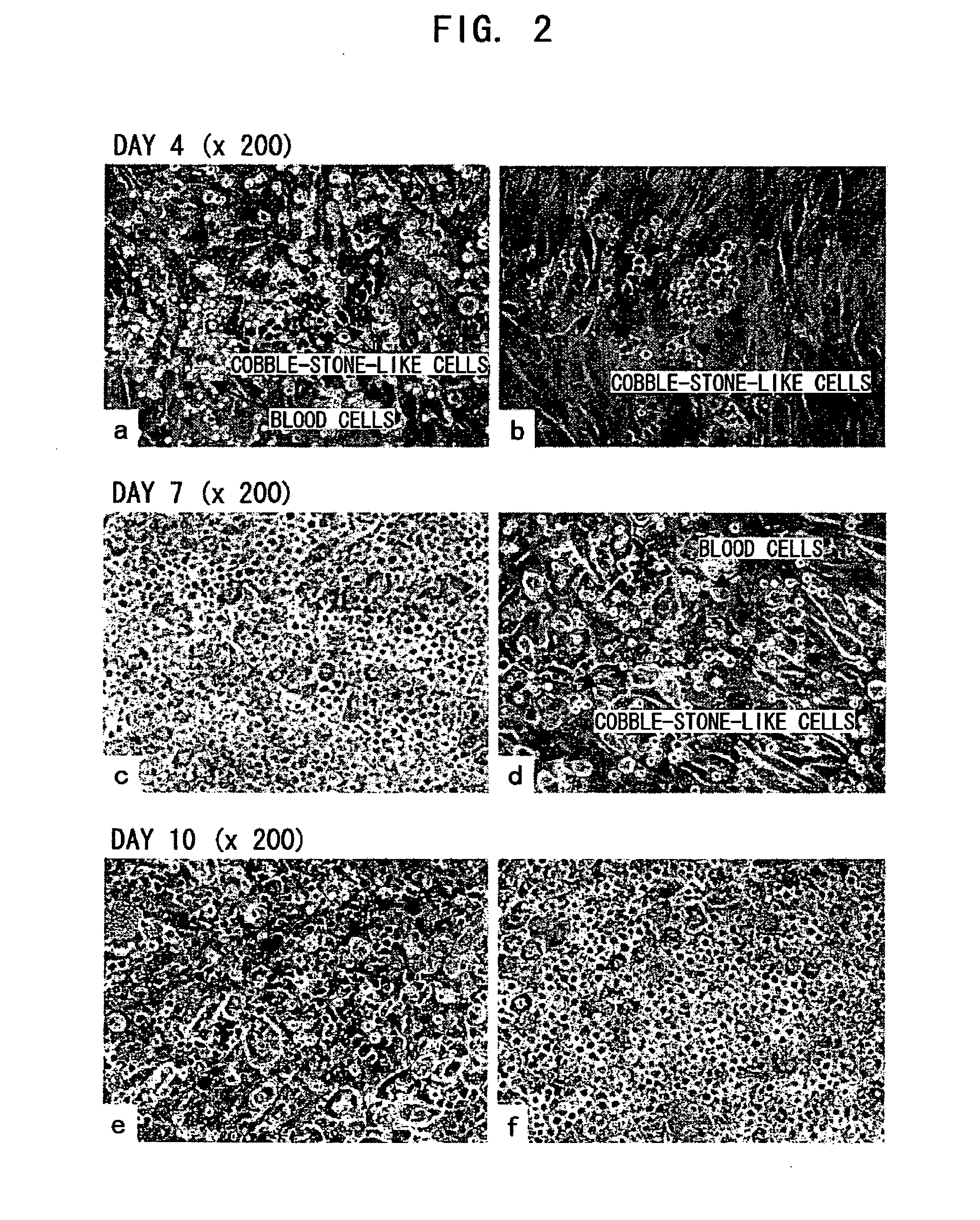Process For Producing Hematopoietic Stem Cells Or Vascular Endothelial Precursor Cells
a technology of vascular endothelial precursor cells and hematopoietic stem cells, which is applied in the direction of non-embryonic pluripotent stem cells, cardiovascular disorders, drug compositions, etc., can solve the problem of limit the supply of embryos, and achieve the effect of inhibiting the angiogenesis
- Summary
- Abstract
- Description
- Claims
- Application Information
AI Technical Summary
Benefits of technology
Problems solved by technology
Method used
Image
Examples
example 1
Isolation Culture of Hematopoietic Precursor Cells and Endothelial Precursor Cells Using Fetal Mouse Liver
Materials
[0191]14.5 days pregnant C57BL / 6 mice
[0192]Phosphate buffered saline (PBS)
[0193]Liver perfusion medium (GIBCO BRL)
[0194]Collagenase / Dyspase solution (GIBCO BRL)
[0195]50 μg / mL gentamicin / 15% fetal bovine serum (FBS) / DMEM (GIBCO
[0196]BRL)
[0197]2% FBS / PBS
[0198]OP9 cell line (Riken BioResource Center RCB 1124)
[0199]Anti-mouse CD16 / 32 monoclonal antibody (Pharmingen)
[0200]Biotinylated anti-mouse PCLP1 monoclonal antibody (MBL)
[0201]PE-labeled anti-mouse CD45 monoclonal antibody (Pharmingen)
[0202]PE-labeled anti-mouse TER-119 monoclonal antibody (Pharmingen)
[0203]7-AAD (Pharmingen)
[0204]Oncostatin M (OSM)
[0205]Basic fibroblast growth factor (bFGF)
[0206]Stem cell factor (SCF)
[0207]Various antibodies against mouse cell surface antigens
[0208]2% paraformaldehyde / PBS
[0209]Goat serum (Wako Pure Chemical Industries Ltd.)
[0210]Block Ace (Snow Brand Milk Products Co., Ltd.)
[0211]Meth...
example 2
Isolation Culture of Hematopoietic Precursor Cells and Endothelial Precursor Cells Using Tissues of Murine Individuals
Materials
[0240]Newborn C57BL6 mice
[0241]PBS
[0242]Collagenase / Dyspase solution (GIBCO BRL)
[0243]50 μg / mL gentamicin / 15% FBS / DMEM (GIBCO BRL)
[0244]2% FBF / PBS, OP9 cell line
[0245]Anti-mouse CD16 / 32 monoclonal antibody (Pharmingen)
[0246]Biotinylated anti-mouse PCLP1 monoclonal antibody (MBL)
[0247]APC-labeled anti-mouse c-Kit monoclonal antibody (Pharmingen)
[0248]FITC-labeled anti-mouse CD34 monoclonal antibody (Pharmingen)
[0249]Streptavidin-APC (Molecular Probes)
[0250]7-AAD (Pharmingen), Oncostatin M (OSM)
[0251]Basic fibroblast growth factor (bFGF)
[0252]Stem cell factor (SCF)
[0253]Various antibodies against mouse cell surface antigens
[0254]MethoCult (Stem Cell Technologies)
Methods
1. Preparation of Tissue Cells (Spleen, Bone Marrow) of Individuals
[0255]The spleen and bone marrow were extirpated from newborn mice. The spleen or bone marrow from a litter of fetuses (six to ...
example 3
Separation of PCLP1-Positive Cells From Human Bone Marrow and Confirmation of Reactivity
Methods
1. Cells
[0271]Human bone marrow monocytes (BMMC) were purchased as frozen cells from Cambrex (Japanese supplier: Sanko Junyaku Co., Ltd.) and then used. The CHO cells used for gene transfer were purchased from the Riken BioResource Center and then subcultured in F12HAM medium (SIGMA) containing 10% FBS (MBL) and 50 μg / mL gentamicin (GIBCO).
2. Gene Transfection and Establishment of a Cell Line in Which the Human PCLP1 Molecule is Forcibly Expressed
[0272]Human PCLP1 cDNA was cloned from a human placenta library, and the full length sequence and extramembrane region sequence were used to make constructs for expression in animal cells using the pcDNA3.1 vector (Invitrogen). The structure of the constructs is shown in FIG. 11. The membrane-expressed recombinant derived from the full length PCLP1 gene can be expressed on the surface of cells such as 293T and CHO, and can be used to evaluate anti...
PUM
| Property | Measurement | Unit |
|---|---|---|
| concentration | aaaaa | aaaaa |
| temperature | aaaaa | aaaaa |
| pH | aaaaa | aaaaa |
Abstract
Description
Claims
Application Information
 Login to View More
Login to View More - R&D
- Intellectual Property
- Life Sciences
- Materials
- Tech Scout
- Unparalleled Data Quality
- Higher Quality Content
- 60% Fewer Hallucinations
Browse by: Latest US Patents, China's latest patents, Technical Efficacy Thesaurus, Application Domain, Technology Topic, Popular Technical Reports.
© 2025 PatSnap. All rights reserved.Legal|Privacy policy|Modern Slavery Act Transparency Statement|Sitemap|About US| Contact US: help@patsnap.com



